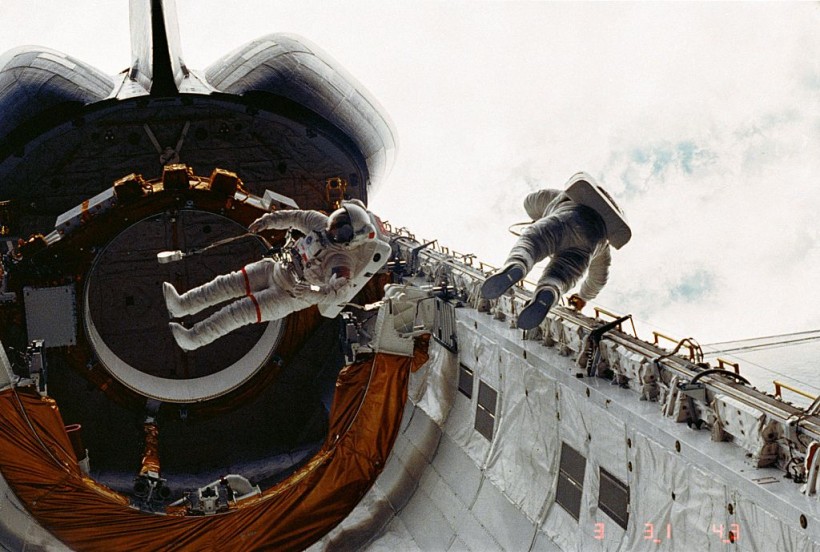The US space agency NASA commemorates the 35th anniversary of the Challenger space shuttle crash on January 28, honoring the historical moment of "grief."
NASA acting Administrator Steve Jurczyk wrote on the agency's website that the space agency and the country lost seven of the family in a moment and left a timestamp on American history.

IN SPACE - APRIL 7: In this handout from the National Aeronautics and Space Administration or NASA, Astronauts Story Musgrave (L) and Don Peterson float in the cargo bay of the space shuttle Challenger during the STS-6 mission on April 7, 1983, in space.
On January 28, 1986, the Challenger was launched from the Kennedy Space Center at Cape Canaveral in Florida. The shuttle exploded seventy-three seconds after takeoff because of what was determined to be a flawed solid-rocket booster.
The seven passengers and crew died. These people are Gregory Jarvis, Christa McAuliffe, Ronald McNair, Ellison Onizuka, Judith Resnik, Dick Scobee, and Mike Smith.
The first instructor in space was set to be McAuliffe. McNair, a scientist, and scientist was the second Black American to travel in space. The tragedy spurred mourning and sympathy from all over the world.
Investigation, Inquiries
The tragedy spawned an inquiry called the Rogers Commission Study into the origin of the blast.
Extreme shortcomings in the technical knowledge of NASA management were established. The booster engine's fault was found to have been triggered by rubber O-rings designed to seal rocket boosters.
The O-rings were never tested to survive the intense cold, which was found on the blast's morning as the shuttle soared higher.
The inquiry noticed that engineers at Morton Thiokol, the government contractor liable for their manufacturing, posed questions regarding the O-rings. Still, these concerns were dismissed by NASA administrators.
Temperatures of -2.2C to -1.7C (28.0F to 28.9F) were seen moments before the flight, much smaller than average for takeoffs.
The study observed that "failures in coordination" culminated in a launch "focused on inaccurate and often deceptive data, a conflict between engineering data and management decisions, and a NASA management system that enabled key Shuttle managers to circumvent internal flight safety concerns."
ALSO READ: Israel's Beresheet Spacecraft Crashes Prior to Historic Lunar Landing
NASA established the Office of Protection, Durability and Quality Assurance in reaction to the inquiry and rebuilt the solid rocket boosters under an independent committee's oversight.
The Deadly Disaster's Lessons
Indeed, many photos, memories, and feelings that prompt pause are returned to mind on the 35th anniversary of this disaster. It also informs us of the vital significance of responsible decision-making and risk oversight as important today as they were more than three decades ago.
According to Space.com, a couple of things that retired space shuttle astronaut Steve Smith said he took from Challenger. The first of them was the risk of human spaceflight, which had to be considered with all that NASA did. He said safety was the number one issue at any single conference when he entered in 1989.
The strategy was rubbed off by younger foreign allies in human spaceflights, such as the European Space Agency (ESA). At the same period, ESA was designing an autonomous transmission vehicle at the ISS for docking cargo. Eventually, the ATV program (which retired in 2015) had all of its spacecraft travel to the space station successfully, dock with critical instruments and supplies, and comfortably fly out.
The second point that Smith recalls NASA stressing is communication value, primarily if anything is not understood by an astronaut or someone else. Not just in one-on-one conversations, but even in broader sessions, Smith said. He said they are allowed to suggest and clarify things.
Smith cautioned that diligence in some of these safe places erodes a little with time. There must be renewed demands to pay heed, as the Columbia event revealed a decade after Challenger to NASA and the city.
An external Columbia Accident Investigative Board (CAIB) report identified the death of Columbia also caused various reasons linked to protection and technological problems. Any CAIB questions mirrored the Rogers Commission's conclusions on Challenger, such as a timetable pressure debate.
However, CAIB noted that the death of Columbia originated from another aspect of the shuttle. Columbia's deadly mission was not the first, as Smith remembered, to suffer foam failure.
Smith said the safety culture at NASA became stronger since the year in which Columbia split up while landing, if not for the Challenger.
NASA honors Apollo 1, Challenger, Columbia, and everyone who gave their lives on their annual Day of Remembrance for space exploration every year. All three of NASA's major accidents arise in the same calendar week.
ALSO READ: NASA's Messenger Mission Comes to an End As Probe Crashes into Mercury's Surface
Check out more news and information on Space on Science Times.














